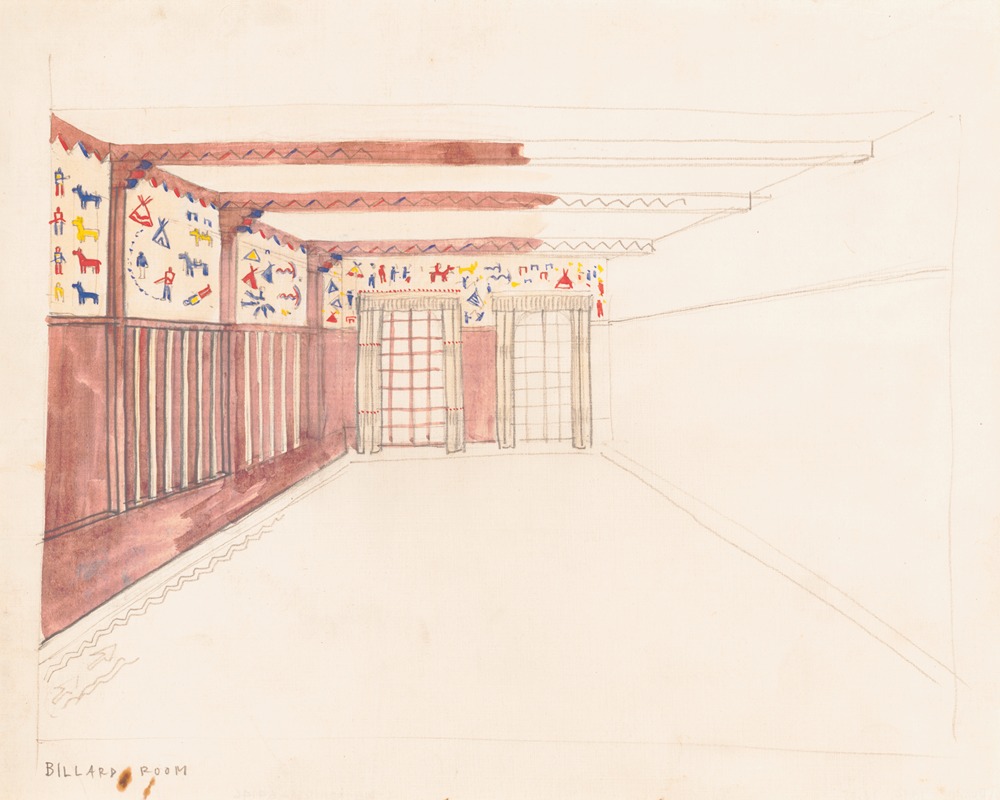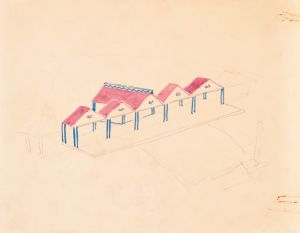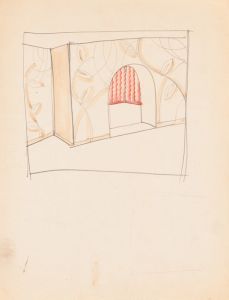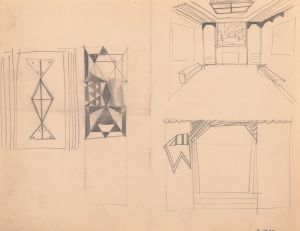
Design drawings for the Theodore Weicker Apartment Building. Sketch for billiard room
A hand-painted replica of Winold Reiss’s masterpiece Design drawings for the Theodore Weicker Apartment Building. Sketch for billiard room, meticulously crafted by professional artists to capture the true essence of the original. Each piece is created with museum-quality canvas and rare mineral pigments, carefully painted by experienced artists with delicate brushstrokes and rich, layered colors to perfectly recreate the texture of the original artwork. Unlike machine-printed reproductions, this hand-painted version brings the painting to life, infused with the artist’s emotions and skill in every stroke. Whether for personal collection or home decoration, it instantly elevates the artistic atmosphere of any space.
Winold Reiss, a German-American artist and designer, is renowned for his contributions to American art and design in the early 20th century. One of his notable works includes the design drawings for the Theodore Weicker Apartment Building, specifically a sketch for the billiard room. This piece exemplifies Reiss's distinctive style, which often combined elements of European modernism with American themes.
Reiss was born in Karlsruhe, Germany, in 1886 and emigrated to the United States in 1913. His background in European art and design, particularly the influence of the Vienna Secession and Jugendstil movements, played a significant role in shaping his artistic approach. Upon his arrival in the United States, Reiss quickly established himself as a versatile artist, working in various mediums including painting, illustration, and interior design.
The Theodore Weicker Apartment Building, for which Reiss created the billiard room sketch, is a testament to his skill in interior design. While specific details about the building's overall design and construction are sparse, Reiss's involvement indicates a high level of artistic and architectural ambition. His design for the billiard room would have been intended to create a sophisticated and aesthetically pleasing environment, reflecting the tastes and social aspirations of the building's residents.
Reiss's sketch for the billiard room likely incorporated his signature use of bold colors, geometric patterns, and intricate detailing. These elements were characteristic of his work and can be seen in other projects he undertook during his career, such as his designs for the Harlem YMCA and the Cincinnati Union Terminal. His ability to blend artistic innovation with functional design made him a sought-after designer for both public and private spaces.
In addition to his design work, Reiss was also known for his portraits, particularly of Native Americans and African Americans. His respectful and dignified representations of these subjects were groundbreaking at a time when such depictions were rare in mainstream American art. This commitment to cultural representation and diversity further underscores the significance of his contributions to American art and design.
Reiss's work on the Theodore Weicker Apartment Building, including the sketch for the billiard room, is an example of his broader impact on the field of interior design. His ability to create spaces that were both beautiful and functional helped to elevate the standards of interior design in the United States during the early 20th century. Although specific details about the billiard room sketch are limited, it is clear that Reiss's involvement would have brought a high level of artistic integrity and innovation to the project.
Overall, Winold Reiss's design drawings for the Theodore Weicker Apartment Building, and particularly his sketch for the billiard room, reflect his unique artistic vision and his significant contributions to the field of interior design. His work continues to be celebrated for its aesthetic quality and cultural significance, making him an important figure in the history of American art and design.





![Graphic design for Fisk Jubilee Singers.] [Concert poster with harp and mask motif](/imgs/249251/s/winold-reiss-graphic-design-for-fisk-jubilee-singers-concert-poster-with-harp-and-mask-motif-3c54d344.jpg)
![Graphic designs for Fortune magazine.] [Study for cover with large telephone lines superimposed over the globe](/imgs/249254/s/winold-reiss-graphic-designs-for-fortune-magazine-study-for-cover-with-large-telephone-lines-superimposed-over-the-globe-2de5efe.jpg)
![[Interior design drawings for unidentified rooms.] [Sketch for room colored green and orange](/imgs/249269/s/winold-reiss-interior-design-drawings-for-unidentified-rooms-sketch-for-room-colored-green-and-orange-9a5c830b.jpg)
![[Miscellaneous small sketches for inlaid table tops.] [Design with dancing couple motif](/imgs/249270/s/winold-reiss-miscellaneous-small-sketches-for-inlaid-table-tops-design-with-dancing-couple-motif-21782590.jpg)


![Interior design drawings for unidentified rooms.] [Sketch for unidentified room with silver wall and ceiling](/imgs/249362/s/winold-reiss-interior-design-drawings-for-unidentified-rooms-sketch-for-unidentified-room-with-silver-wall-and-ceiling-af719bb9.jpg)
![Interior perspective drawings of Hotel Siwanoy, Mount Vernon, NY.] [Interior perspective study of Grill in red, yellow, and orange](/imgs/249369/s/winold-reiss-interior-perspective-drawings-of-hotel-siwanoy-mount-vernon-ny-interior-perspective-study-of-grill-in-red-yellow-and-orange-5860095.jpg)
![Proposed decorations for Fisher Building, Detroit.] [Theatre foyer 109 & adjacent galleries](/imgs/249387/s/winold-reiss-proposed-decorations-for-fisher-building-detroit-theatre-foyer-109-adjacent-galleries-88035d64.jpg)
![Design proposals for Puck Theater, New York, NY.] [Interior perspective study.](/imgs/249414/s/winold-reiss-design-proposals-for-puck-theater-new-york-ny-interior-perspective-study-ba0eb061.jpg)
![Designs for theater with black-framed proscenium and boldly colored settings.] [Study for stage light wall decoration, possibly for Caf ̌Crillon](/imgs/249423/s/winold-reiss-designs-for-theater-with-blackframed-proscenium-and-boldly-colored-settings-study-for-stage-light-wall-decoration-possibly-for-caf-crillon-5f9976e0.jpg)

